MAGIC Begins Bounceback as Pandemic Wanes
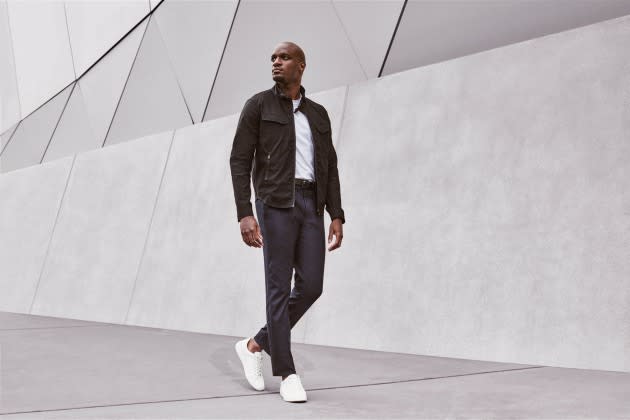
LAS VEGAS — It isn’t back to “normal” yet — however that’s defined these days — but it’s definitely moving in the right direction.
That was the consensus of the retailers and vendors who turned out for the MAGIC and Project show here earlier this week.
More from WWD
After a shaky return to an in-person event in August, the vibe and attendance were markedly better this time. But there was still a lack of large vendors, particularly at the men’s show. Although some bigger brands did exhibit — Polo Ralph Lauren, Peerless, Scotch & Soda, Mavi and Pendleton among them — most of the brands were smaller and lesser known.
But Kelly Helfman, president of Informa Markets Fashion, who oversees the shows, was still upbeat about how the fashion industry turned out to support the event.
All told, she said, 1,500 brands showed at the combined MAGIC, Sourcing at MAGIC and Project shows, with 500 companies exhibiting at the latter — a 15 percent increase over last August. While she did not reveal the number of attendees, she cited a higher number of department stores, owner-operators, online and international retailers with 35 percent of the retailers new to the show.
“A lot of the travel restrictions that we saw last August have been lifted,” she said.
She acknowledged that the men’s part of the show — its historical strength — is different today with most of the high-end, traditional brands opting to show at the Chicago Collective or other regional shows. Instead, Project and MAGIC’s niche is to highlight streetwear and emerging brands with a more casual bent. The women’s brands, which now dominate the show, are also more focused on the contemporary market than the juniors and licensed labels of the past.
“We are moving where the industry is going,” she said.
Although Helfman remains upbeat about the show continuing to expand as the pandemic wanes, there will be another issue in August when MAGIC’s dates once again overlap with Chicago’s, like they did last summer, forcing men’s retailers to choose between the two.
This time, MAGIC wasn’t the only game in town, other shows also came to Las Vegas to offer retailers an option. These included Agenda, the streetwear-skewed show, the Off-Price Show and the Las Vegas Apparel Show, part of the International Market Centers, which owns the Atlanta Apparel Center. The Vegas show, held at the World Market Center on the outskirts of town, successfully tested the waters in August and tripled the number of women’s contemporary apparel and accessories brands at this edition, showcasing around 100 brands. “And we expect next August to be even bigger,” said Alejandra Trombetta, senior events manager.
At the main event, retailers who attended Project and MAGIC were upbeat as business has been solid and they embraced the opportunity to return to live events.
“It was good to be back in person and a reminder that after two years away, nothing can replace touching product and meeting face-to-face with existing and potential partners,” said Durand Guion, vice president of the fashion office for Macy’s Inc. “Although we would have liked to see more brands exhibiting, those who made the effort must be applauded and we found a mix of emerging and continuing trends including craftwork and embroidery, abstract appliqués on Ts and fleece, print mixing in every variety, Southwest influences, utility details and new iterations of the varsity trend.”
Patty Leto, senior vice president and general merchandise manager of menswear at The Doneger Group, said the stores are generally feeling cautiously optimistic as they look to the remainder of this year.
“This past fall season was very strong, and while there was a little pullback at the end because of Omicron, we did see things start to come back at the end of January and into February,” she said.
While headwinds remain because of the lingering supply chain issues and “rising prices are a concern,” Leto said retailers are expecting a good first quarter thanks in part to a later Easter, which will put less pressure on stores that are experiencing late deliveries.
For fall, Leto said comfort will continue to reign supreme. In addition, utilitarian details; outdoor-inspired dressing, jeans in the new stacked flare model from Smoke Rise and EPTM, among others; wovens; flannels for layering, and a new color palette of green, brown and other earthy hues with pops of orange and red are also expected to be popular later this year. Knits that look like wovens from Flag & Anthem and Civil Society were also standouts, she said, along with corduroy tops.
Dana Katz of Miltons, a Massachusetts-based men’s chain, said attending MAGIC allows him to complete his buying for the season. “It’s an easy way to make more progress on our shopping list, see new vendors and goods from different countries,” he said.
He, along with Anthony DiGirolamo of Garage Clothing in Brooklyn, found some vendors from Turkey offering sharp prices on tailored clothing that will allow them to compete more effectively with the larger stores and obtain higher margins.
While they both agreed that the Chicago Collective was a superior show overall, they knew that they could only find lesser-known brands in Vegas, so it was worth the trip.
Katz said overall, his business in 2021 was decent and he is “very optimistic” about 2022. He said the customer today is “shopping with greater purpose,” and he’s enjoying more referrals as people seek a more-personal touch. “We’re hopeful that this is the time for specialty stores,” he said.
Zaid Hamid, the 29-year-old founder and owner of Denver-based men’s and women’s store Steadbrook, said his visit to Vegas marked his first time back to a trade show since 2019. Although his initial plan was to go to Paris as he expands his high-end contemporary brands, that didn’t work out so he opted for Vegas instead.
“We missed the in-person component and seeing fabrics and products,” he said, adding that buying from line sheets doesn’t have the same impact.
He enjoyed the sense of discovery he had at the show and found at least four or five brands he hadn’t been familiar with before as he scoured the aisles for “memorable” pieces to complement the basics in his assortment. “People are willing to spend money on brands that offer excitement,” he said.
Last year sales at Steadbrook rebounded, and while there’s still a lot of uncertainty, he’s hopeful about the future. “Onward and upward,” he said.
Here are some standout men’s and women’s brands that can hopefully help fuel that trajectory.
Kenneth Cole Collection
Designer: Kenneth Cole, creative director, Matteo Gottardi, designer
Backstory: Peerless Clothing last year bought the license for Kenneth Cole clothing from Oxford Industries and cut a deal to create a premium men’s contemporary sportswear collection. After testing a few pieces for spring, such as five-pocket pants and polos, Peerless unveiled the full sportswear collection at Project intended to define a “new way of dressing,” according to Dan Orwig, president of Peerless.
Key styles: The five-pocket pants, crews, Ts and technical blazers and bombers are augmented by trucker jackets, comfort hoodies, reversible vests, a knit blazer that looks like a cardigan, a reversible sherpa jacket, quilted chore jackets, joggers with a removable drawstring at the waist, high-performance stretch wovens and a striking peacoat with raw edges.
Retail prices: T-shirts will sell for $39, polos for $59, five-pocket chinos are $89.50, the comfort hoodie is $155 and the peacoat tops out at $195.
We the Free
Backstory: Although the sister brand to Free People has been around for several years, this marked the first time the line was showcased in its own booth at the Project show. The collection, which is rooted in denim, is intended to offer women “an effortless cool way of dressing,” according to Kate Chase-Lansdale, general manager of global wholesale for Free People. In addition to a range of trend-right jeans, We The Free offers tops and accessories. Both Free People and We The Free, along with Anthropologie, are part of Urban Outfitters Inc.
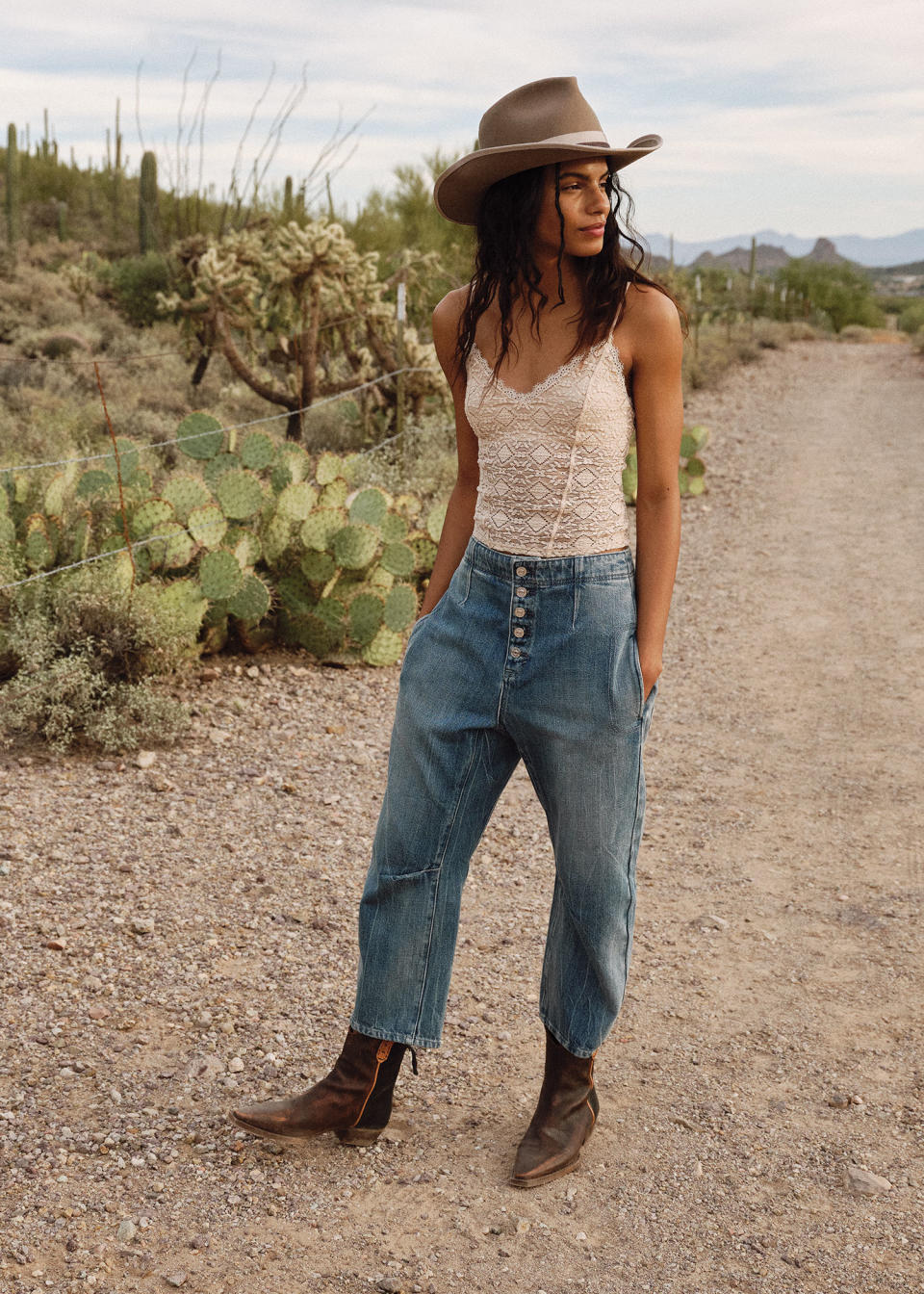
Key styles: The Marcy jumpsuit and the Ziggy overalls are among the most popular denim styles for fall, joining a variety of new fits in jeans that are flared and a lot more slouchy. Top models for fall include the Old West Slouchy, which Chase-Lansdale described as “very drippy;” the Just Float, with an exaggerated flared bottom, and the Jayde Flare, which is more understated. There are also a variety of Western-inspired boots, all of which sport the brand’s signature three-nailhead detail, as well as the Vella T-shirt, available in long or short sleeves, denim jackets, an oversize trucker, a Ruby shirt-jacket, a Dolman jacket and an assortment of accessories ranging from handbags and backpacks to wallets and belts.
Retail prices: Denim prices start at $78 and go up to $128. The T-shirt is $58, the denim jacket is $128 and the Dolman jacket is $198. A distressed wallet is $48 and a sling fannypack is $78.
LaRopa
Designers: Ari Sanchez and Jimbo Williiams
Backstory: Sanchez and Williams moved from Toronto to New York City in 2016 with $500 in their pockets and a place to sleep for only a few days. After that they were homeless for two years as they worked to establish a foothold in fashion. It wasn’t until they moved to Los Angeles that they finally found success when celebrities including Bella Hadid, Rihanna, Jay-Z and Jake Paul discovered the brand. LaRopa, Spanish for “the clothing,” now operates two stores in L.A. and one in New York’s SoHo. Their display served as the introduction of their first cut-and-sew collection.
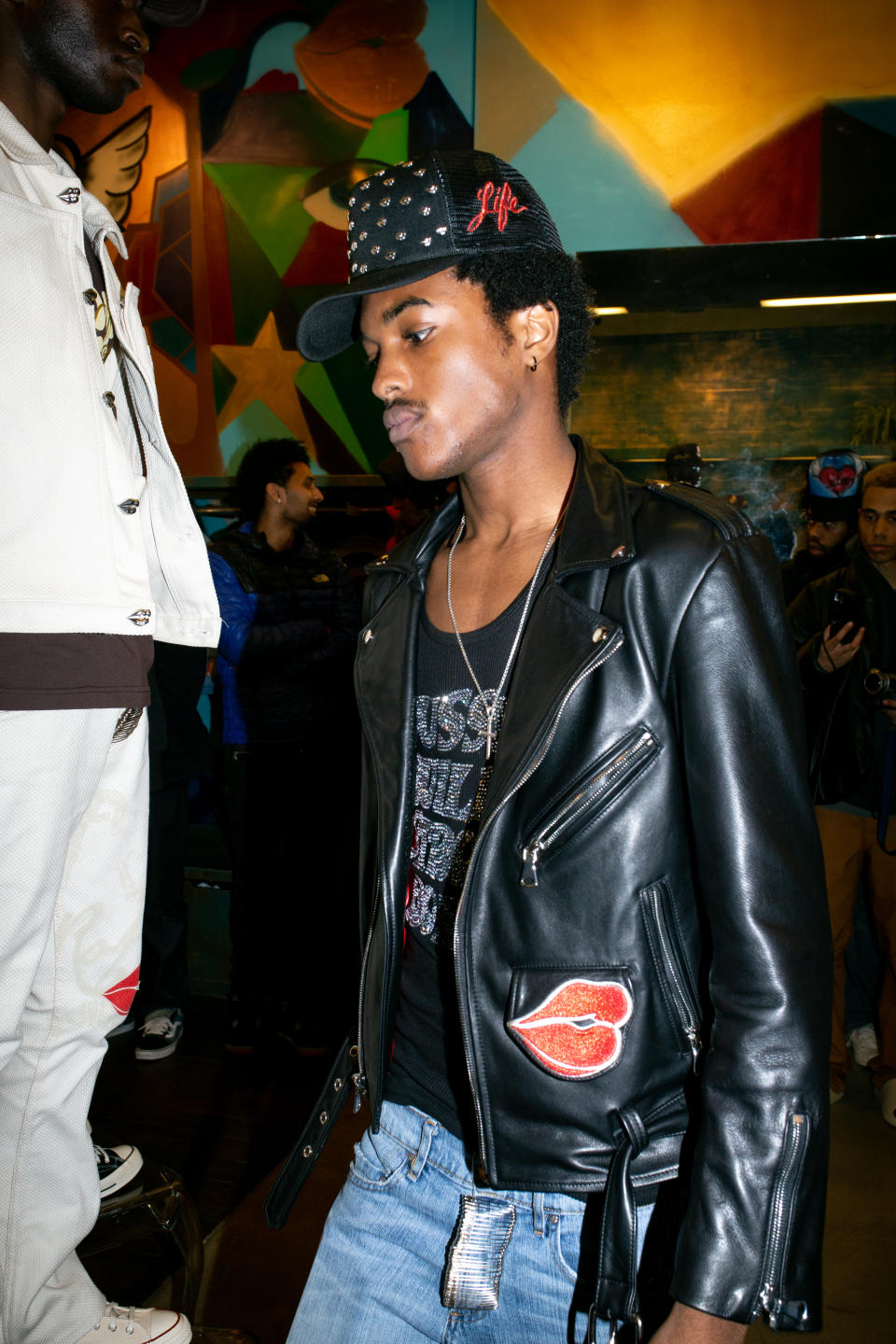
Lane
Key styles: LaRopa is best known for the big red lips that embellish everything from T-shirts to leather jackets. “It’s about love and affection,” Sanchez explained of the brand’s signature graphic. While it’s known for its Ts, the collection included a long-sleeved thermal top with finger holes; sweatpants with safety pins on the crotch; a french terry polo; flared jeans in Japanese denim and lip rivets; a leather motorcycle jacket; a vegan fur vest, and a denim jacket that opens up to display 15 pockets.
Retail prices: The french terry polo is $300, the flared jeans are $600 with a ripped version retailing for $750, ringer cut-and-sewn Ts are $200, the leather moto jacket is $2,500 and the vegan vest is $600.
B/M/C
Designer: Brandon Murphy
Backstory: The California native started his brand, Brandon Murphy Collection, with womenswear but pivoted into menswear five years ago. He started out creating made-to-measure tailored pieces in unconventional fabrics such as silks and velvets and introduced his first off-the-rack collection at Project. He describes his aesthetic as “a luxury tailoring brand that expresses love for individuality and elegance by expounding upon historic sartorial elements through cultural references with a modern touch.”
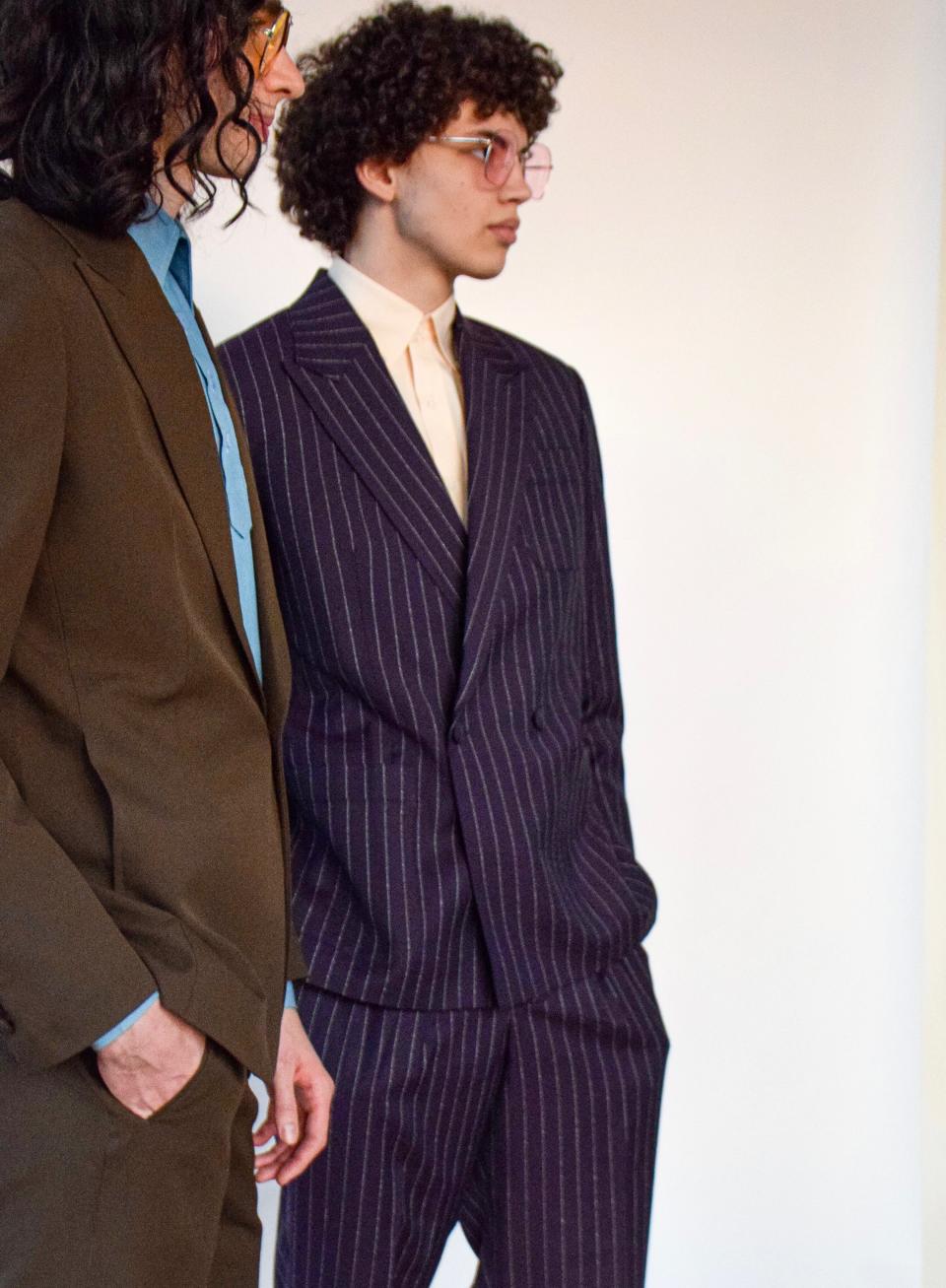
Key styles: A velvet dinner jacket with a shawl lapel is paired with wide-legged high-waisted trousers; a pink satin silk suit features a double-breasted jacket with silk-covered buttons, high-waisted pants and bell-bottom trousers; a single-breasted suit in cotton and silk with double button waistband and jetted hip pockets on the pants and hidden pockets on the jacket, and a gun metal suit with a double button closure inspired by a shift cuff and pick stitching on the lapels. In addition, Murphy introduced his version of a penny loafer with three personalized silver coins on the front rather than just one. “Good things come in threes,” he said.
Retail prices: The velvet suit is $1,550, the pink suit and the gunmetal suit are both $1,350, and the loafers are $395.
Gigi Pip
Backstory: The six-year-old brand was founded by Ginger and Jon Parrish as a women’s hat brand to celebrate the many hats women wear. The hats are designed in Salt Lake City and the collection offers around 50 styles in a range of materials. About one-and-a-half years ago, the brand expanded into men’s with a collection called Two Roads. All the women’s hats are named after women while the men’s models are named after below-the-radar cities.
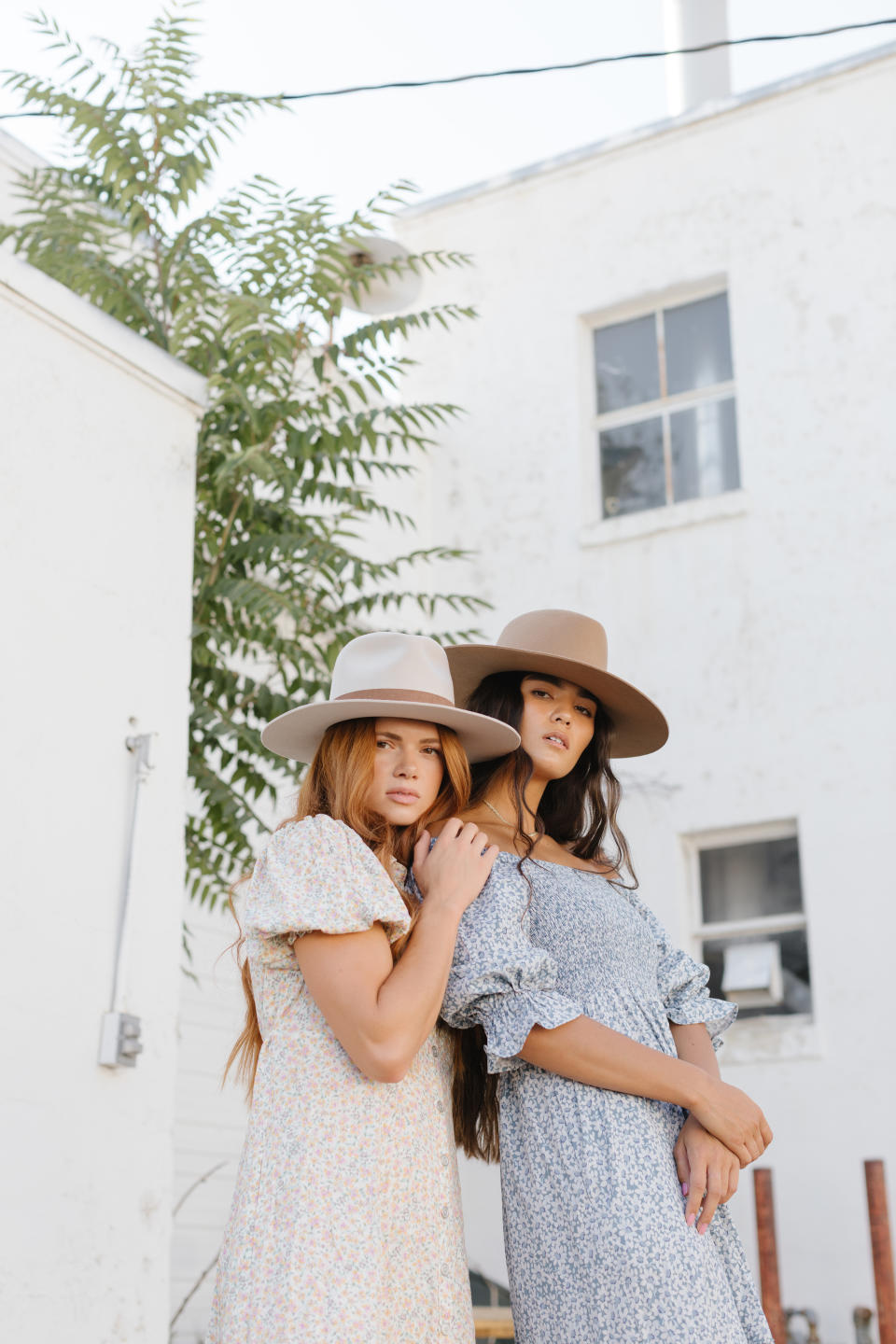
roslyn smithers
Key styles: The hats are offered in materials ranging from felt to straw in styles ranging from buckets to ball caps. The bestselling women’s hats include the Monroe, a pinched crown fedora; the Maude, a pencil brim style, and the Cove, the signature Mexico-made high-quality straw hat. For men, the Echo Park is a pencil roll hat with a suede band and the Five Points offers a distinct crown shape while the Elliston is a rancher hat. In order to personalize the hats, the company offers an assortment of bands that can be mixed and matched to “trim your brim.”
Retail prices: The hats retail for $90 to $140.
Kanata
Designer: Pam Mander
Backstory: Kanata Hand Knits is a homegrown family business founded in 1979 whose wool sweaters are still handmade in Canada. Run today by second-generation sister and brother Pam and Dave Mander, Kanata’s designs are inspired by the distinct pattern and thick wool style that originated with the Cowichan, a Coast Salish people from Vancouver Island. All the styles are made from 100 percent pure wool in a variety of colors and patterns, as well as exclusive designs for specialty partners such as Maharashi, Moncler Genius and retailer No Man Walks Alone.
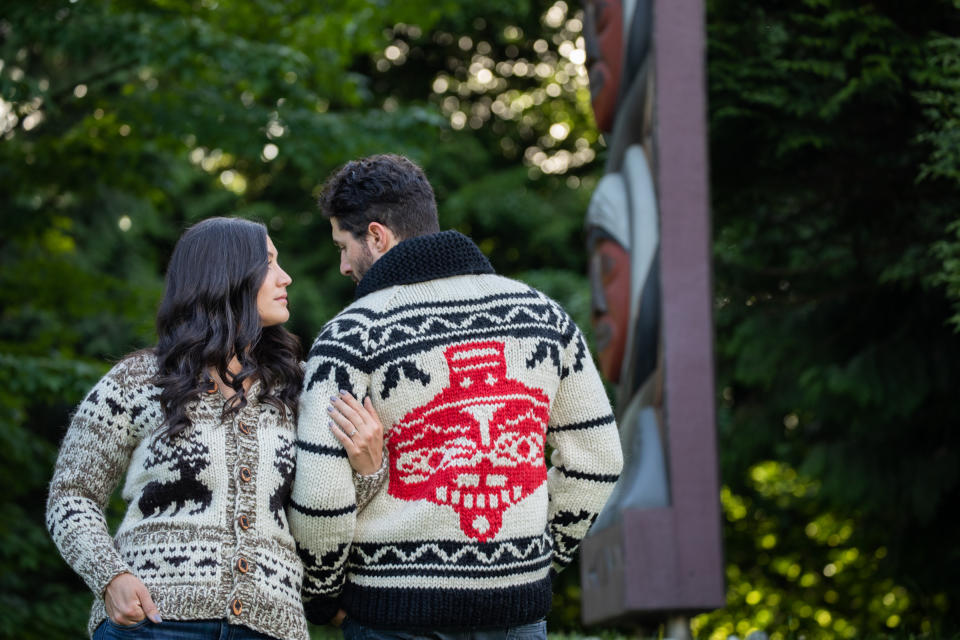
Key styles: A cardigan-style sweater is made with six-ply 100 percent virgin wool with traditional Cowichan patterns and details such as a shawl collar, Talon zipper with a leather zipper pull, and pattern-matching patch pockets at the hip.
Retail prices: Pricing ranges between $375 and $475 for the legacy Cowichan-inspired hand-knit wool sweaters.
Todd Patrick
Designer: Desyree Nicole
Backstory: Desyree Nicole and Gabriella Paulino are the masterminds behind the Black- and women-owned brand Todd Patrick. Nicole, a former Division I basketball player, began styling NFL players after college and discovered a gap in the menswear market for “cool, luxury styles” in bigger and custom sizes, and Todd Patrick was born in 2016. The duo opened their first brick-and-mortar shop at Buckhead Village in Atlanta this past year. Nicole, who hails from Michigan, balances refined staples mixed with hints of streetwear, a fusion of relaxation and grit.
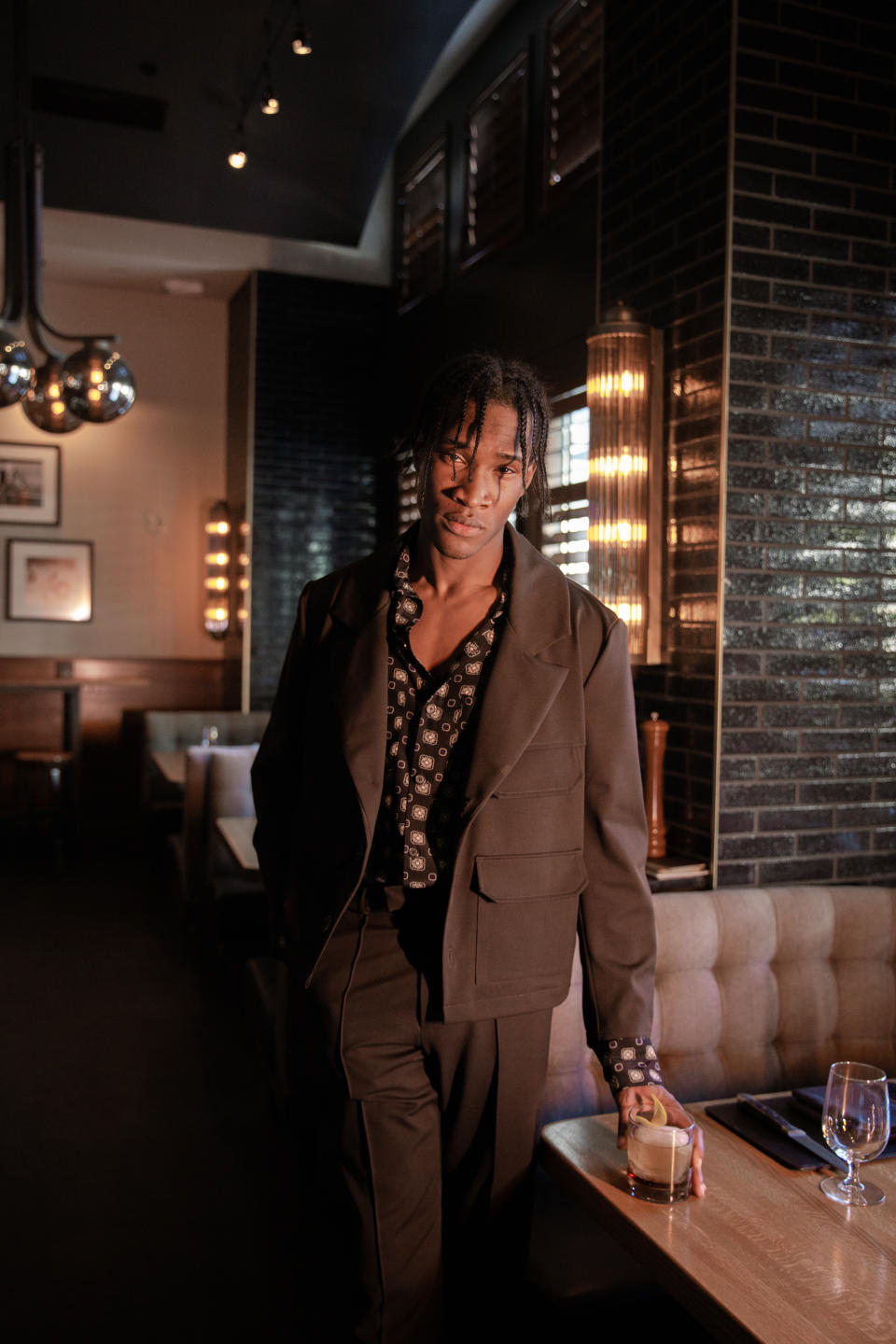
Key styles: Inspired by vintage pieces, the collection includes double-breasted boxy suits, powder blue leather flared pants, clean Cuban-style crocheted button-downs, a boxy floor-length topcoat in a vibrant yellow, and a blue pony hair trucker jacket.
Retail prices: Pricing for the assortment begins at $200 for the Ts, $500 for silk shirts, $1,600 for the cashmere-blend top coats and $2,200 for the pony hair pieces.
Knititude
Designer: Julie Jun
Backstory: Helmed by designer Julie Jun, founder of shuttered contemporary womenswear brand Maj, the Korean-based brand focuses on affordable and sustainable knitwear by implementing 3D knitwear technology. The brand ethos is simple: no seams, no cutaways, zero waste and elevating quality knitwear by fusing superfine lambswool with alpaca, silk with organic cotton as well as cashmere blends.
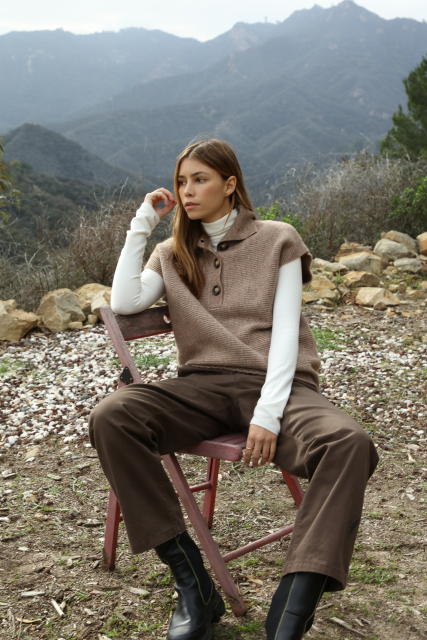
Key styles: Launched last spring, the seamless program propels the more novelty-driven pieces. For fall, the focus turns to sweater sets, loungewear gets an updated professional touch with palazzo lounge pants paired with collared sweaters (for those home Zoom meetings), cropped tops with matching cardigan sets, and more novelty pieces such as skirts, cropped tops and leggings.
Retail prices: For the seamless program, pricing starts in the low $30s, with knitwear at $100 and below, and cardigan coats rounding off between $170 and $180 with the latter including the heavier pieces.
Nia
Designer: Sonia Parvaneh
Backstory: Based in L.A., Nia launched at the end of 2019, with a focus on the lounge and athleisure space. The feminine basics label has found success despite the fact that the COVID-19 pandemic began just as it was beginning to take its first steps. From Plush sweater joggers and cropped raglan knits, Nia focuses on women who value comfort yet don’t want to compromise style and appreciate a feminine edge and cozy feel.
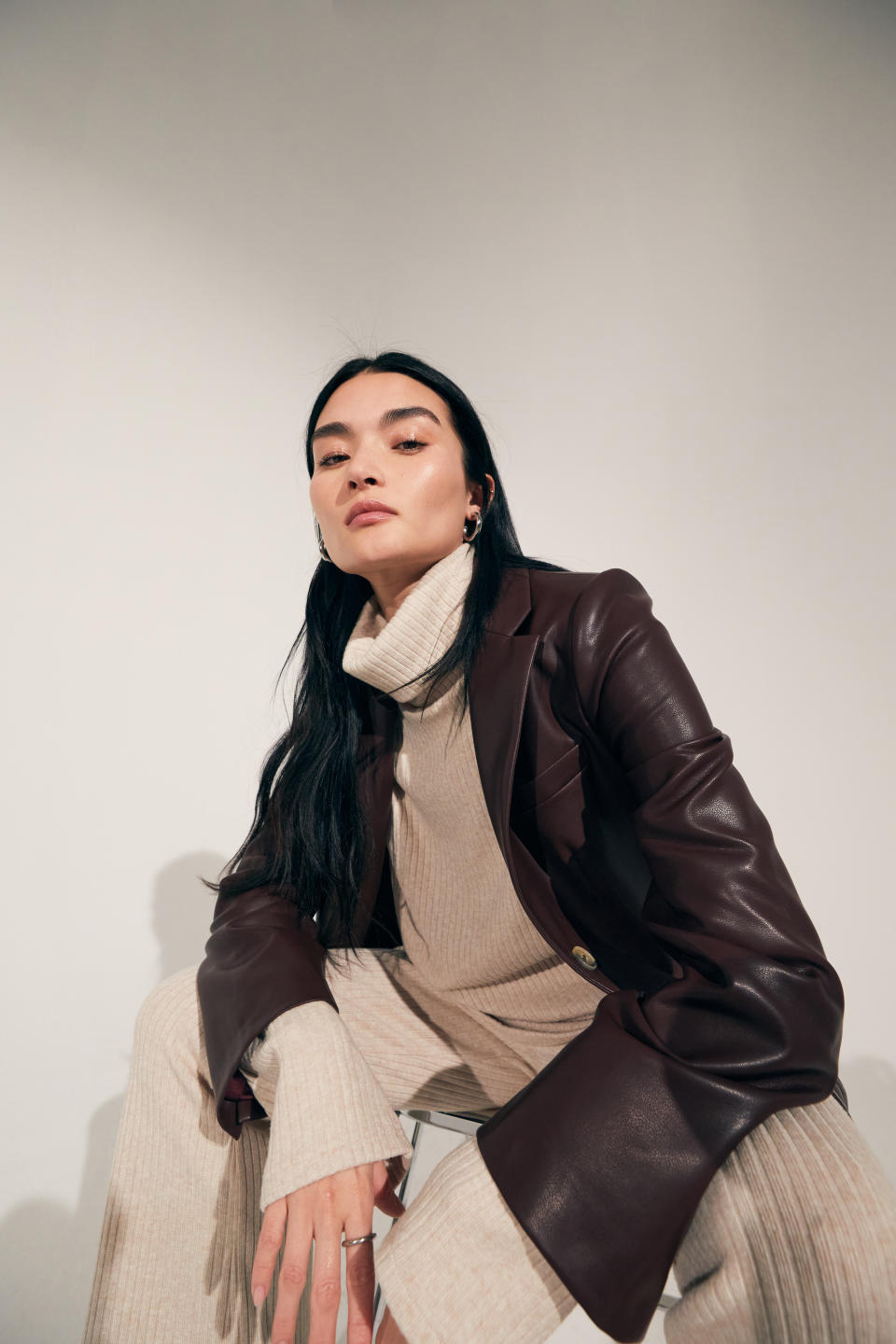
SCOTT LEON
Key styles: Faux-fur vests (introduced for fall), patent leather statement outerwear, Plush cardigan sweater sets, velour tracksuits and shearling shackets are among the top styles.
Retail prices: The assortment lands at retail with a range of $60 to $100 with knitwear ranging from $78 to $88 and tops starting at $38.
Carlton Jones
Designer: Carlton Jones
Backstory: The brand launched in 2015, but Jones has a long background in retail as well as styling for the likes of Queen Latifah, Halle Berry, Aretha Franklin, Erykah Badu, Jill Scott and First Lady Michelle Obama. The brand is all about relaxed, fluid luxury design with a resort-themed assortment built around sustainable practices and fabrics, not to mention size inclusivity. In 2020 Jones was one of Harlem’s Fashion Row recipients of the Icon 360 x A Common Thread $1 Million Grant prize, in conjunction with Vogue and the CFDA.
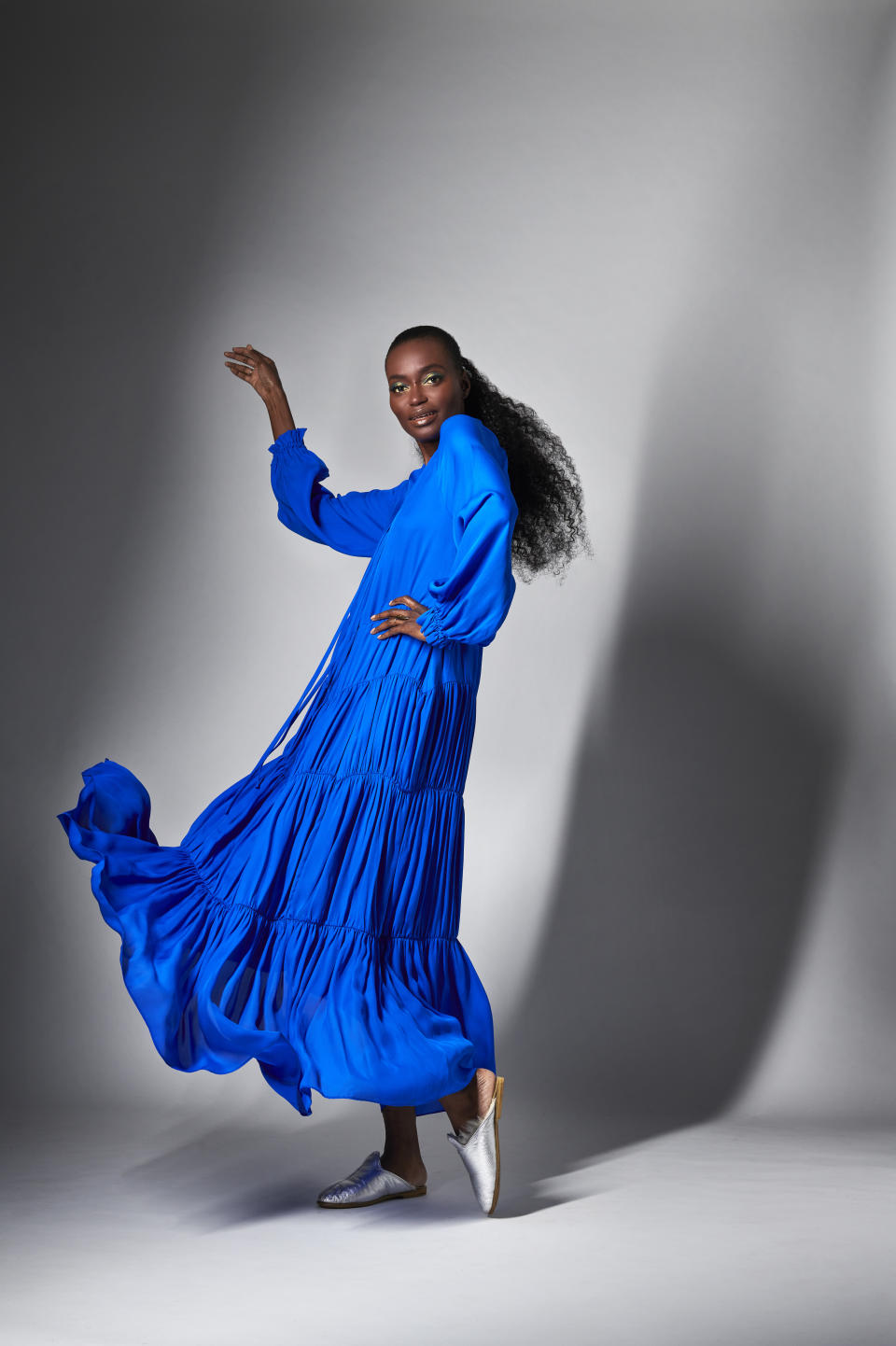
Key styles: Jumpsuits with cargo pants and an elasticated cinched waist in lightweight Tencel; loose harem-style pants with adjustable with belts and ties; floor-length silk anorak in a vibrant coral tone; a silk charmeuse tunic; color-blocked dresses; silk tiered royal blue tunic dress, and bamboo knit tank dresses.
Retail prices: The dresses range from $985 to $1,150, with pants at $300 to $330 and tank dresses at $410.
Sign up for WWD's Newsletter. For the latest news, follow us on Twitter, Facebook, and Instagram.

